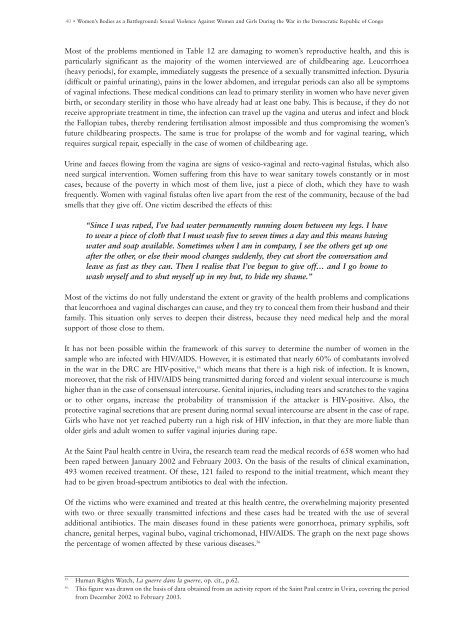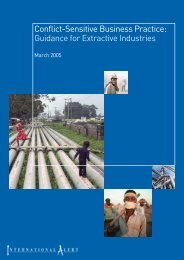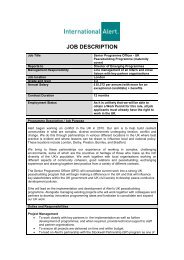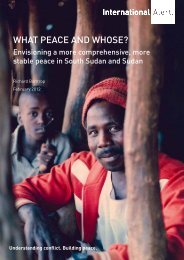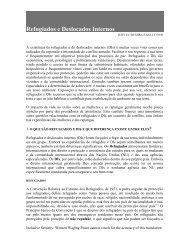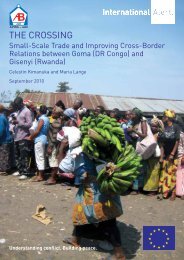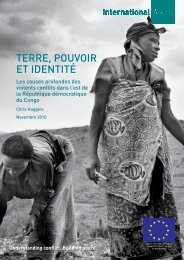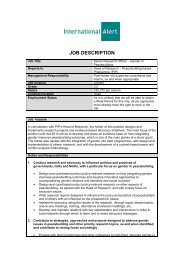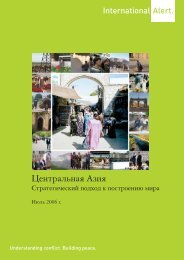Full report - International Alert
Full report - International Alert
Full report - International Alert
- No tags were found...
You also want an ePaper? Increase the reach of your titles
YUMPU automatically turns print PDFs into web optimized ePapers that Google loves.
40 • Women’s Bodies as a Battleground: Sexual Violence Against Women and Girls During the War in the Democratic Republic of CongoMost of the problems mentioned in Table 12 are damaging to women’s reproductive health, and this isparticularly significant as the majority of the women interviewed are of childbearing age. Leucorrhoea(heavy periods), for example, immediately suggests the presence of a sexually transmitted infection. Dysuria(difficult or painful urinating), pains in the lower abdomen, and irregular periods can also all be symptomsof vaginal infections. These medical conditions can lead to primary sterility in women who have never givenbirth, or secondary sterility in those who have already had at least one baby. This is because, if they do notreceive appropriate treatment in time, the infection can travel up the vagina and uterus and infect and blockthe Fallopian tubes, thereby rendering fertilisation almost impossible and thus compromising the women’sfuture childbearing prospects. The same is true for prolapse of the womb and for vaginal tearing, whichrequires surgical repair, especially in the case of women of childbearing age.Urine and faeces flowing from the vagina are signs of vesico-vaginal and recto-vaginal fistulas, which alsoneed surgical intervention. Women suffering from this have to wear sanitary towels constantly or in mostcases, because of the poverty in which most of them live, just a piece of cloth, which they have to washfrequently. Women with vaginal fistulas often live apart from the rest of the community, because of the badsmells that they give off. One victim described the effects of this:“Since I was raped, I’ve had water permanently running down between my legs. I haveto wear a piece of cloth that I must wash five to seven times a day and this means havingwater and soap available. Sometimes when I am in company, I see the others get up oneafter the other, or else their mood changes suddenly, they cut short the conversation andleave as fast as they can. Then I realise that I’ve begun to give off… and I go home towash myself and to shut myself up in my hut, to hide my shame.”Most of the victims do not fully understand the extent or gravity of the health problems and complicationsthat leucorrhoea and vaginal discharges can cause, and they try to conceal them from their husband and theirfamily. This situation only serves to deepen their distress, because they need medical help and the moralsupport of those close to them.It has not been possible within the framework of this survey to determine the number of women in thesample who are infected with HIV/AIDS. However, it is estimated that nearly 60% of combatants involvedin the war in the DRC are HIV-positive, 55 which means that there is a high risk of infection. It is known,moreover, that the risk of HIV/AIDS being transmitted during forced and violent sexual intercourse is muchhigher than in the case of consensual intercourse. Genital injuries, including tears and scratches to the vaginaor to other organs, increase the probability of transmission if the attacker is HIV-positive. Also, theprotective vaginal secretions that are present during normal sexual intercourse are absent in the case of rape.Girls who have not yet reached puberty run a high risk of HIV infection, in that they are more liable thanolder girls and adult women to suffer vaginal injuries during rape.At the Saint Paul health centre in Uvira, the research team read the medical records of 658 women who hadbeen raped between January 2002 and February 2003. On the basis of the results of clinical examination,493 women received treatment. Of these, 121 failed to respond to the initial treatment, which meant theyhad to be given broad-spectrum antibiotics to deal with the infection.Of the victims who were examined and treated at this health centre, the overwhelming majority presentedwith two or three sexually transmitted infections and these cases had be treated with the use of severaladditional antibiotics. The main diseases found in these patients were gonorrhoea, primary syphilis, softchancre, genital herpes, vaginal bubo, vaginal trichomonad, HIV/AIDS. The graph on the next page showsthe percentage of women affected by these various diseases. 5655.Human Rights Watch, La guerre dans la guerre, op. cit., p.62.56.This figure was drawn on the basis of data obtained from an activity <strong>report</strong> of the Saint Paul centre in Uvira, covering the periodfrom December 2002 to February 2003.


